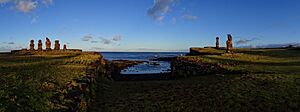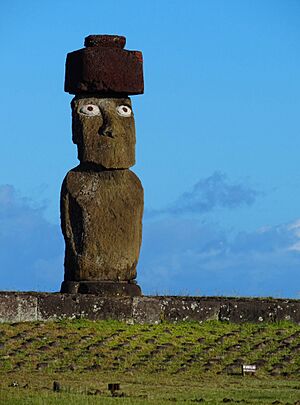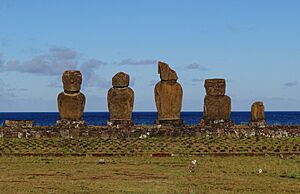Tahai facts for kids
The Tahai Ceremonial Complex is an amazing archaeological site located on Rapa Nui, also known as Easter Island. This island is part of Chilean Polynesia, far out in the Pacific Ocean. Tahai was carefully restored in 1974 by an American archaeologist named William Mulloy.
At Tahai, you can see three main ahu (stone platforms) lined up from north to south. These are Ko Te Riku, Tahai, and Vai Ure. Ko Te Riku is special because its moai (large stone statue) has restored eyes, which is rare. From Tahai, you can also see two other restored ahu at a place called Hanga Kio'e. William Mulloy also worked on those projects in 1972.
Contents
What is Tahai?
Tahai is a very important part of the Rapa Nui National Park. This park is recognized by UNESCO as a World Heritage site. This means it's a place of great importance to everyone in the world. Mulloy also helped restore other famous sites on the island, like Ahu Akivi, the ceremonial village of Orongo, and Ahu Vinapu. His work helped protect these ancient places for future generations to learn from and enjoy.
Who was William Mulloy?
William Mulloy was a dedicated archaeologist who spent many years studying and restoring the ancient structures of Easter Island. His work was crucial in preserving the history and culture of the Rapa Nui people. He and his wife, Emily Ross Mulloy, are buried at Tahai, showing how much this place meant to them.
Exploring the Ahu at Tahai
The ahu at Tahai are platforms where the ancient Rapa Nui people placed their giant stone statues, the moai. These platforms were important for ceremonies and rituals.
Ahu Ko Te Riku
Ahu Ko Te Riku is known for its single moai that stands proudly on the platform. What makes this moai unique is that it has restored eyes made of white coral with red scoria (a type of volcanic rock) for the pupils. Most moai do not have their eyes anymore, so seeing this one helps us imagine how they might have looked long ago.
Ahu Tahai
Ahu Tahai is the central platform in the complex. It is a large and impressive structure, showing the skill of the ancient builders. While the moai on this platform are not as complete as Ko Te Riku's, the platform itself is a great example of Rapa Nui architecture.
Ahu Vai Ure
Ahu Vai Ure is another significant platform at Tahai. It features several moai in various states of preservation. Together, these three ahu give visitors a wonderful look into the past and the incredible achievements of the Rapa Nui civilization.
See also
 In Spanish: Tahai para niños
In Spanish: Tahai para niños




